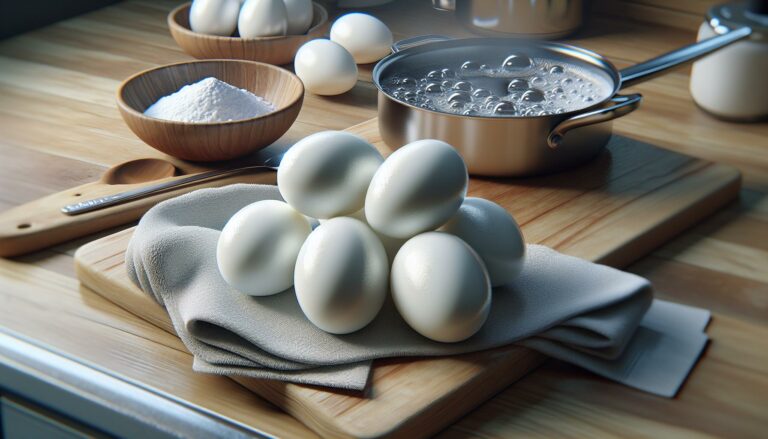Standing in the kitchen with a mixing bowl ready but no baking soda in sight? It’s a common kitchen crisis that has frustrated many home bakers. While baking powder and baking soda might seem like culinary cousins their chemical properties make them quite different in how they work their magic in recipes.
Many people wonder if they can simply swap one for the other but it’s not quite that simple. These two white powders may look identical but they create different reactions in your baked goods. Understanding the difference between these leavening agents can mean the difference between perfectly risen muffins and flat disappointment.
Understanding Baking Soda and Baking Powder
Baking soda and baking powder serve as leavening agents in baking recipes. These white crystalline compounds create the essential rise and texture in baked goods through distinct chemical reactions.
Chemical Composition and Properties
Baking soda (sodium bicarbonate) consists of a pure chemical compound that activates when combined with acidic ingredients like buttermilk, yogurt, or vinegar. The reaction produces carbon dioxide gas bubbles, causing dough or batter to expand. Baking powder contains sodium bicarbonate plus added acidic compounds (cream of tartar) and cornstarch. This mixture creates a double-acting effect – one reaction occurs when mixed with liquid ingredients, and another happens when exposed to heat during baking.
Key Differences Between the Two Leavening Agents
Baking soda starts working immediately upon contact with acidic ingredients at room temperature. Baking powder provides a delayed, two-stage reaction process for optimal leavening. The amount required varies significantly – recipes typically use 2-3 times more baking powder than baking soda for equivalent leavening power. Baking soda creates a more immediate, vigorous reaction that requires careful timing during baking. Baking powder offers more control with its gradual release of carbon dioxide throughout the baking process.
| Leavening Agent | Activation Time | Amount Needed (vs. Baking Soda) | pH Level |
|---|---|---|---|
| Baking Soda | Immediate | 1x | 8.5-9.0 |
| Baking Powder | Gradual | 2-3x | 7.0-7.2 |
Substituting Baking Powder for Baking Soda

Converting baking soda to baking powder requires precise measurements to maintain proper leavening action. The substitution process affects both the chemical reaction and final outcome of baked goods.
The Basic Conversion Formula
A 1:3 ratio serves as the standard conversion when replacing baking soda with baking powder in recipes. For every 1 teaspoon of baking soda, add 3 teaspoons (1 tablespoon) of baking powder to achieve equivalent leavening power. This ratio accounts for baking powder’s lower concentration of sodium bicarbonate.
| Original Amount (Baking Soda) | Substitute Amount (Baking Powder) |
|---|---|
| 1/4 teaspoon | 3/4 teaspoon |
| 1/2 teaspoon | 1 1/2 teaspoons |
| 1 teaspoon | 3 teaspoons |
| 2 teaspoons | 6 teaspoons |
Impact on Recipe Taste and Texture
Baking powder creates a more neutral taste profile compared to baking soda’s alkaline flavor. The texture becomes lighter with smaller air bubbles distributed throughout the baked item. Changes appear in:
- Rise patterns: Products show gradual expansion rather than immediate lift
- Crumb structure: Results in finer texture with more uniform holes
- Color development: Produces lighter browning on the exterior
- Moisture content: Creates slightly drier finished products
- Storage life: Extends shelf stability due to balanced pH levels
The cornstarch in baking powder adds a minimal starch content that affects the final product’s structure.
When the Substitution Works Best
Substituting baking powder for baking soda succeeds in specific recipes where the chemical reactions align with the desired outcome. Understanding these scenarios helps bakers achieve optimal results when making ingredient adjustments.
Suitable Recipe Types
Recipes containing naturally acidic ingredients work effectively with a baking powder substitution. Quick breads like banana bread incorporate acidic fruits that complement the leavening action. Chocolate cakes benefit from cocoa powder’s natural acidity paired with baking powder’s gradual rise. Muffins baked with yogurt or buttermilk maintain proper texture using baking powder. Sugar cookies perform well due to their simple chemistry requiring minimal rise. Pancakes adapt easily to baking powder’s double-acting properties creating fluffy results.
Required Recipe Adjustments
The recipe’s liquid content requires reduction by 2-3 tablespoons per cup when using baking powder. Salt quantities decrease by 1/4 teaspoon for every tablespoon of baking powder to balance sodium levels. Mixing time extends by 30 seconds to incorporate the additional powder volume thoroughly. Baking temperatures remain constant while baking times increase by 3-5 minutes to accommodate the gradual rise. Acidic ingredients like buttermilk reduce by 1/4 cup per recipe to prevent over-reaction. Storage containers require airtight sealing as baked goods with baking powder stay fresh 1-2 days longer.
Potential Risks and Limitations
Substituting baking powder for baking soda carries specific risks that affect the final quality of baked goods. Understanding these limitations helps prevent common baking mishaps.
Recipe Failures to Watch Out For
Incorrect substitution ratios lead to dense textures or collapsed centers in cakes or quick breads. Over-measurement of baking powder creates a metallic aftertaste in delicate recipes like sugar cookies or vanilla cakes. Dense or gummy textures occur in recipes requiring immediate chemical reactions, such as Irish soda bread or buttermilk biscuits. Uneven rising patterns emerge in layer cakes or cupcakes due to baking powder’s delayed reaction time. Cookie spreads become unpredictable, resulting in either too much spread or insufficient spread during baking.
When to Avoid Substituting
Chemical leavening substitutions fail in recipes with high acid content like lemon bars or sourdough breads. Traditional recipes dependent on baking soda’s browning properties produce pale results with baking powder, including gingersnaps or soft pretzels. Deep chocolate recipes lose their rich color intensity as baking powder alters the pH balance. Recipes requiring precise rise timing, such as cream puffs or Yorkshire puddings, become unstable. Commercial baking operations avoid substitutions due to cost differences between these leavening agents.
Alternative Leavening Options
Several proven alternatives create rise in baked goods when baking soda remains unavailable. These substitutes produce varying levels of leavening action through different chemical reactions.
Natural Substitutes
Whipped egg whites create natural leavening through mechanical aeration in recipes like angel food cake or soufflés. Club soda adds carbonation plus moisture to pancakes or quick breads, replacing 1 teaspoon of baking soda with ¼ cup of club soda. Self-rising flour contains leavening agents mixed with all-purpose flour, providing reliable rise for biscuits or muffins. Yogurt or buttermilk introduces acidity plus beneficial bacteria that react with other ingredients to create lift in baked goods. Baker’s yeast generates carbon dioxide through fermentation, working effectively in bread recipes that allow time for proofing.
Emergency Kitchen Swaps
Potassium bicarbonate serves as a direct 1:1 substitute for baking soda in recipes requiring immediate leavening. Cream of tartar mixed with baking soda (2:1 ratio) creates a homemade baking powder substitute. Active dry yeast (1 teaspoon) replaces baking soda (½ teaspoon) in bread recipes with a 30-minute rest period. Molasses combines with white vinegar (1 tablespoon each) to substitute for 1 teaspoon of baking soda in quick breads. Double-acting baking powder (1 tablespoon) replaces baking soda (1 teaspoon) in most standard recipes.
Conclusion
While baking powder can substitute for baking soda in many recipes it’s essential to understand the proper ratios and adjustments needed. Success lies in using three times more baking powder than the called-for amount of baking soda and making necessary recipe modifications.
Bakers should remember that this substitution works best in recipes with naturally acidic ingredients and may require adjustments to liquid content mixing time and baking duration. For optimal results consider exploring alternative leavening agents when baking soda isn’t available.
The key to successful baking lies in understanding these ingredients’ unique properties and making informed decisions about substitutions based on specific recipe requirements.




